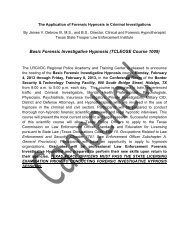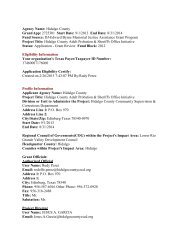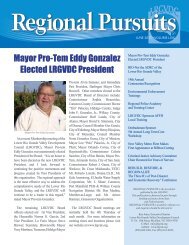Watershed Protection Plan - Lower Rio Grande Valley Development ...
Watershed Protection Plan - Lower Rio Grande Valley Development ...
Watershed Protection Plan - Lower Rio Grande Valley Development ...
Create successful ePaper yourself
Turn your PDF publications into a flip-book with our unique Google optimized e-Paper software.
STATE OF THE WATERSHED<br />
Figure 13. 24-hour Dissolved Oxygen Values for Stations in the Tidal (13072 and 13073) and Above Tidal (13074 and<br />
13081) Segments of the Arroyo Colorado<br />
25<br />
Arroyo Colorado 24-Hour Dissolved Oxygen<br />
20<br />
Dissolved Oxygen (mg/L)<br />
15<br />
10<br />
5<br />
0<br />
May 05<br />
Aug 05<br />
Apr 04<br />
Jul 04<br />
May 05<br />
Aug 05<br />
Aug 98<br />
Jul 02<br />
Oct 02<br />
May 03<br />
Jul 03<br />
Aug 03<br />
Oct 03<br />
Apr 04<br />
Jul 04<br />
May 05<br />
Aug 05<br />
Aug 98<br />
Aug 98<br />
Jul 99<br />
Jun 00<br />
May 02<br />
May 03<br />
Aug 03<br />
Apr 04<br />
Jul 04<br />
May 05<br />
Aug 05<br />
13081 13074<br />
NON-TIDAL<br />
13072 - Zone of Impairment<br />
TIDAL<br />
13073<br />
24-hour average criteria<br />
24-hour minimum criteria<br />
analysis of water samples collected in the Arroyo<br />
Colorado between 2000 and 2002, the average<br />
concentration of fi ve-day biochemical oxygen demand<br />
(BOD5) at the downstream end of the non-tidal segment<br />
of the Arroyo Colorado was 4.7 mg/l (Figure 14).<br />
Average BOD5 concentrations were found to be<br />
slightly higher in the upper portion of the tidal segment<br />
of the Arroyo Colorado (6.7 mg/l). However, this is<br />
thought to be the result of periodically high organic<br />
matter production in-stream. The higher growth of<br />
microscopic algae during algal blooms in the upper<br />
portion of the tidal segment of the Arroyo Colorado<br />
produces suspended organic matter in the form of<br />
millions of algal cells. These cells produce large<br />
amounts of BOD as they die and are decomposed<br />
by bacteria. Filtered water samples from the tidal<br />
segment of the Arroyo Colorado show an average<br />
BOD5 concentration comparable to that of the non-tidal<br />
segment (4.7 mg/l).<br />
Nitrogen<br />
Nitrogen is an essential plant nutrient. Along with<br />
other nutrients such as phosphorus, plants need only<br />
water and light to grow. This includes microscopic<br />
aquatic algae also known as phytoplankton. Low<br />
concentrations of nutrients can reduce plant growth<br />
and therefore impede the production of food for<br />
organisms that are dependent on this growth, while<br />
high concentrations of nutrients can cause excessive<br />
and uncontrolled growth of algae in aquatic systems<br />
(i.e., algal blooms). Nitrogen-containing substances are<br />
often measured to assess water quality on a short-term<br />
(acute) or long-term (chronic) basis. Elevated ammonia<br />
nitrogen levels can contribute to high phytoplankton<br />
growth rates, but high levels of ammonia nitrogen<br />
can also have an acute (toxic) effect on aquatic life.<br />
Elevated levels of nitrate and nitrite nitrogen often<br />
lead to nutrient enrichment concerns, especially in<br />
coastal water bodies. High levels of ammonia and<br />
nitrate nitrogen are often caused by nonpoint source<br />
Arroyo Colorado <strong>Watershed</strong> <strong>Protection</strong> <strong>Plan</strong> 42 January 2007









